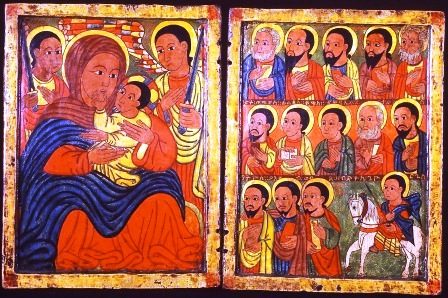Sculpture seems to have very few artisans and patrons in Ethiopia while there is a fascination with painting. It dates back to the beginnings of the Christian era at least; but the plundering of invaders meant that relatively little from earlier than the sixteenth century has been preserved.
The medieval school of Ethiopian painting was dominated by Byzantine influences, which is to say the Byzantine style of art, not necessarily Byzantium itself (whenever Byzantine art is used in this post it is referring to the style not the location). With the rise of this new capital and art patronage, the Gondarene artistic period formed from the historical tradition (Byzantine).
Byzantine art is marked by more symbolic approach to the subject matter as opposed to, say, Classical art, which attempts to be more realistic and less symbolic. The subject matter of Byzantine art is more often than not religious (Christian) or royal in nature. The most commonly seen examples of Byzantine art are usually mosaics and murals from churches or icons. Icons often depicted the Virgin with the Christ Child and, sometimes flanked by saints and angels. An Ethiopian example of an icon can be seen in this tempera on panel example, entitled Diptych with Virgin and Child flanked by archangels, apostles, and Saint George, from the late 15th century.

The Byzantine style of art can be identified by numerous characteristics. These are, but are not limited to:
1. The use of rich, bright colors (often the colors found in a Crayola 8-box of crayons)
2. Flat figures that seem to float on the surface and are piled on in a frontal pose
3. Detail is avoided and drapery is often simple and curvilinear
4. Large eyes and one facial type
5. Gold background
Many of these characteristics are seen in this mural that stretches across the ceiling at The Debre Berhan Selassie Church in Gondar. The ceiling is covered by hundreds of faces with wings (angels). All of them are a flat (2) facial type with large eyes (3) depicted with bright colors (1) on a gold background (5).
Even today much of the art in Ethiopia continues to reflect the cultural tradition that was reinvented at Gondar.






No comments:
Post a Comment